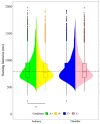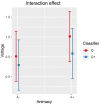The role of animacy in language production: evidence from bare noun naming
- PMID: 39221693
- PMCID: PMC12181646
- DOI: 10.1177/17470218241281868
The role of animacy in language production: evidence from bare noun naming
Abstract
According to Levelt's language production model, to name an object, speakers must first conceptualise and lexicalise the object before its name can be articulated. Conceptualisation is conducted through the semantic network that exists at the conceptual level, with the highly activated concept(s) activating lexical items at the lemma level, that is, lexicalisation. So far, research focused mostly on semantic categories (i.e., semantic interference) but less so on animacy-a concept that is correlated with semantic categories. To investigate the role of this semantic feature in language production, we conducted a picture-word interference study in Mandarin Chinese, varying animacy congruency and controlling for classifier congruency while recording behavioural and electrophysiological responses. We observed an animacy interference effect together with a larger N400 component for animacy-incongruent versus congruent picture-word pairs, suggesting animacy-congruent concepts may be in closer proximity and hence lead to a stronger spreading of activation relative to animacy-incongruent concepts. Furthermore, a larger P600 component was observed for classifier-incongruent versus classifier-congruent picture-word pairs, suggesting syntactically driven processing of classifiers at the lemma level.
Keywords: Language production; Mandarin Chinese classifiers; N400; P600; animacy; bare noun naming; picture-word interference.
Conflict of interest statement
Declaration of conflicting interestsThe author(s) declared no potential conflicts of interest with respect to the research, authorship, and/or publication of this article.
Figures








References
-
- Ahmad I., Ansari F., Dey U. K. (2012). A review of EMG recording technique. International Journal of Engineering Science and Technology, 4(2), 530–539.
-
- Bates D. (2007). Linear mixed model implementation in lme4. Manuscript, University of Wisconsin, 15, 5–2.
-
- Bates D., Mächler M., Bolker B., Walker S. (2014). Fitting linear mixed-effects models using lme4. arXiv preprint arXiv:1406.5823.
MeSH terms
LinkOut - more resources
Full Text Sources

